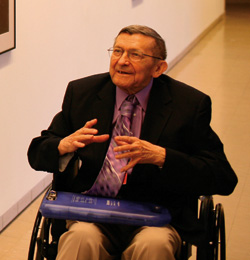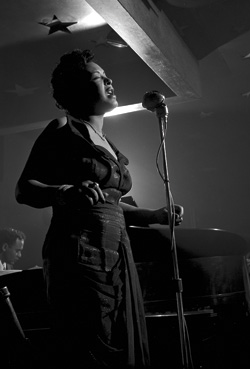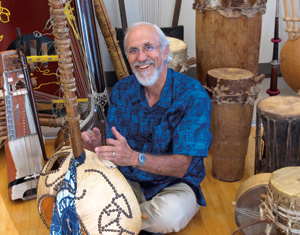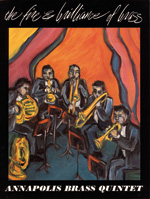Collectors’ Additions
When Patricia Bakwin Selch donated the Selch Collection of American Music History to Oberlin in 2008, she apparently started a trend: Oberlin has since been given several significant collections.
Jazz Seen

Frank Kuchirchuk
(photo by John Seyfried)
Frank Kuchirchuk is a retired photographer who took live performance photographs of Billie Holiday, Dizzy Gillespie, Charlie Parker, Art Tatum, Stan Getz, Lester Young, Coleman Hawkins, and other jazz greats at Lindsay’s Sky Bar, a popular 1950s Cleveland nightclub. Kuchirchuk has donated some 200 jazz images, representing his entire collection of the genre, to Oberlin. Most of the images are negatives that have never been printed or published. Unlike portraiture, publicity stills, or session shots, his work captures the energy of a live performance and provides a fascinating glimpse into the artists’ performance styles.
“His lighting is just exquisite,” says Associate Professor of Art Pipo Nguyen-duy. “He intuitively set the lighting so that he could interpret each performer’s unique personality. His work really speaks to the decisive moment: in the Billie Holiday photograph, you see how she places her hand on the microphone, how the room and the lines in it come together at a precise moment. If you pick the wrong split-second, it’s no longer a ‘photograph.’ He seemed able to anticipate a certain moment three or four seconds before it happened.”
Placing Kuchirchuk’s work in context, Nguyen-duy says that the photos “capture that particular spirit of that exciting moment in jazz and in the city of Cleveland … when Cleveland was one of the major centers for jazz.”

Frank Kuchirchuk's photograph of
Billie Holiday
What motivated Kuchirchuk to donate his photographs to Oberlin? “I didn’t know what to do with them until I read about Oberlin,” he says. A November 2007 Plain Dealer article about several million dollars in gifts donated to Oberlin for the Kohl Building inspired him. “I thought, ‘Hey—everybody knows about Oberlin!’” Kuchirchuk intuited that Oberlin’s reputation as one of the country’s top conservatories, as well as its national profile, would secure for the collection the protection and attention it deserves.
“This is a tremendous gift,” said the late Professor of African American Music and Chair of Jazz Studies Wendell Logan. “Typically there are a few popular photos that reappear in different contexts that we’re all familiar with. His catalog consists of photos that have never been seen before. For students to see images of the people who actually created the music that they’re learning to play—in various performance contexts—is a very beneficial thing. These names jump from the page when you can associate a picture with them. We are certainly indebted to him for thinking of us.”
The Frank Kuchirchuk Collection of Jazz Photography will be cataloged and archived within the Kohl Building, where a selection will ultimately be on display. A small exhibition is currently on view in the conservatory lounge; virtual visitors can see and learn more at www.oberlin.edu/conservatory.
All the Sounds of the World
A bana, a three-stringed Indian fiddle, and a humanatone, a toy nose flute, are among the more than 280 unusual instruments that comprise a collection assembled by Emeritus Professor of Ethnomusicology Roderic Knight, who retired in 2008 following 32 years of teaching at Oberlin. Knight, who acquired his personal collection of world instruments over a lifetime of globetrotting, has donated them to the conservatory.
Knight was serving in the Peace Corps, teaching secondary-school music in Sierra Leone, when he discovered the kora, a harp played by professional musicians of the Mandinka people. He began making field recordings in his free time, an endeavor that ignited his interest in ethnomusicology. He returned to West Africa often, beginning with sojourns to Gambia, to continue his study of Mandinka music, focusing on the kora for his PhD in ethnomusicology at UCLA. One subsequent trip resulted in the purchase of a set of handpicked koras for his Mandinka Ensemble at Oberlin, instruments now part of the collection. Travels to India also yielded unique items, among them the bin-baja, a small, five-string harp played with a pick.

Emeritus Professor of Ethnomusicology
Roderic Knight
(photo by Dale Preston ’83)
Although most of Knight’s acquisitions were the direct result of fieldwork, he actually began collecting instruments as a high school student; the first instrument in the collection is the binai, a Thai double reed that he found in a Los Angeles gift shop. When an authentic, full-size instrument was not available, Knight was inclined to make a prototype. One in particular is his favorite—the marimbula, a boxy instrument from the Dominican Republic with three wide metal tongues that produce a deep, booming sound when plucked. After conducting field research on the instrument with former student Elio Trabal ’04, the two, not wanting to buy the marimbula player’s own instrument, built a replica of it from photos and decorated it with Oberlin’s colors of crimson and gold.
Knight says that over the years he collected some “oddball things that others might not think of collecting;” those items are nonetheless quite valuable to the field of organology, the study of instrument classification.
Knight always took instruments to his classes so that students could see the actual items they were studying. Assistant Professor of Ethnomusicology Jennifer Fraser continues this practice, noting that Knight’s collection “really is an amazing teaching resource,” making the learning experience “much more visceral for the students.”
His collection, which will be stored in the Kohl Building, can be viewed online at www.oberlin.edu/library/digital.
Brass Tracks
The Annapolis Brass Quintet, the first independent, full-time performing brass chamber ensemble in the United States, donated its entire collection of published music scores and parts, music manuscripts, and related correspondence—more than 1,000 individual items—to the conservatory.
Dean of the Conservatory David H. Stull, himself a brass player, says: “This donation establishes at Oberlin one of the largest and certainly one of the most extensive brass chamber music collections in the United States. Our students in the brass department will now be able to access and engage not only a phenomenal range of works in the traditional canon, but also many works commissioned by the ensemble. The Annapolis Brass Quintet made an enormous contribution to the literature of brass chamber music, and Oberlin is honored to be the beneficiary of that tremendous work.”
The gift was celebrated with a November 2008 concert in Warner Concert Hall that featured performances of works from the Annapolis collection by student and faculty ensembles—including the Oberlin Brass Ensemble, directed by Professor of Trombone James DeSano and including Associate Professor of Trumpet Roy Poper, Professor of Horn Roland Pandolfi, and Teacher of Tuba Ron Bishop—and guest artists the Tower Brass Quintet. Past and present members of the Annapolis Brass were guests of honor.
Throughout its distinguished 22-year career (the Annapolis Brass Quintet was founded in 1971 and disbanded in 1993) the ensemble presented 75 world premieres representing works by such composers as Robert Hall Lewis, Lawrence Moss, Robert Starer, and Pulitzer Prize-winner George Walker ’41. All of the ensemble’s commissioned scores, as well as a large number of unpublished manuscripts—some of which may be the only copies in existence—are included in the gift to Oberlin.

“Choosing a home for the library was one of the most difficult decisions the quintet had to make when it closed down,” says founding member Robert Posten, a bass trombonist and tubist. Making the library easily accessible to the greatest population of brass players and scholars, and selecting an institution that would steward the collection for the benefit of future generations, were the critera guiding the ensemble’s search for the library’s permanent home. To that end, the collection is not only on Oberlin’s conservatory library shelves, it is also accessible through OBIS, the electronic catalog of all materials held by the Oberlin College Library.
